Dell XPS 13 Review
by Brett Howse on February 19, 2015 9:00 AM EST- Posted in
- Laptops
- Dell
- Ultrabook
- Broadwell-U
- XPS 13
Display
Dell offers two display choices in the XPS 13. The base model comes with an IPS 1920x1080 (Full HD, or FHD) Sharp 1420 panel, with LED backlighting of course. The upgrade is to the Sharp 1421 panel, which increases the resolution to 3200x1800 (QHD+), for 272 pixels per inch. Even 1080p on a 13.3 inch panel is a nice resolution, but the high DPI display really shines, especially in the new Windows 8 environment. Desktop apps can still have some issues with High DPI, but it is becoming less of a problem over time.
Sharp is the maker of all IGZO displays, which we have seen before in a couple of other devices such as the Razer Blade. The big benefit to IGZO (Indium Gallium Zinc Oxide) panels is they allow more light through the display, reducing the power requirements for the backlight. This generally means that we get to keep the full RGB stripe, which should help with color accuracy.
Being able to see both sets of pixels just shows how many more pixels are packed into the High DPI panel. 1080p is around 2 million pixels and 3200x1800 is 5.76 million pixels. It is a big difference and gives a big increase to clarity, but it comes with the cost of increased power usage, despite the IGZO TFT.
Dell has the displays listed as IPS (In-Plane Switching) panels on their spec sheet, and they do not seem to have any of the off-angle color shift of a VA (Vertical Alignment) design. Whatever the display type, it certainly is not TN (Twisted Nematic) so even at extreme angles there is not the loss of contrast associated with those displays. Also, you can see the anti-glare coating on the FHD pixels, which is the distortion shown on the subpixels.
To test the panels, we turn to SpectralCal’s CalMAN 5 software suite, the X-Rite i1Display Pro Colorimeter for brightness and contrast measurements, and the X-Rite i1Pro Spectrophotometer to measure the color accuracy.
One more note about the Dell displays though is that they have an auto-brightness adjustment with no way to disable it. It seems to manifest itself the most, and the most severe, when there are large contrast changes on-screen. For this reason, our automated testing for the color accuracy would not work at all because of the abrupt changes on the screen as it flashed among the various colors. This would cause the screen to go bright and dim and caused some very erroneous readings.
I was able to get around it for the color testing by manually going to on-screen color patterns, however display calibration is impossible with this brightness adjustment so that was skipped. I have contacted Dell to inquire about this issue and will give an update if they get back to me.
Update: Dell has enabled Content-Adaptive Backlight Control, which we have seen in other devices like the Nokia Lumia 930. Dell has let me know they are looking into a way to have the end user disable this feature.
First up is the brightness, contrast, and black levels.
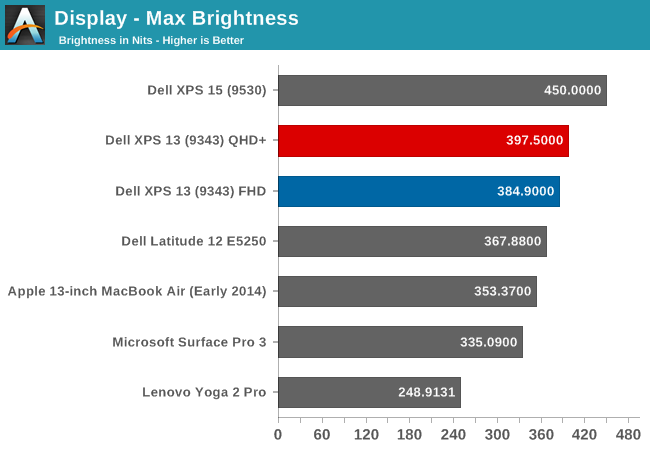
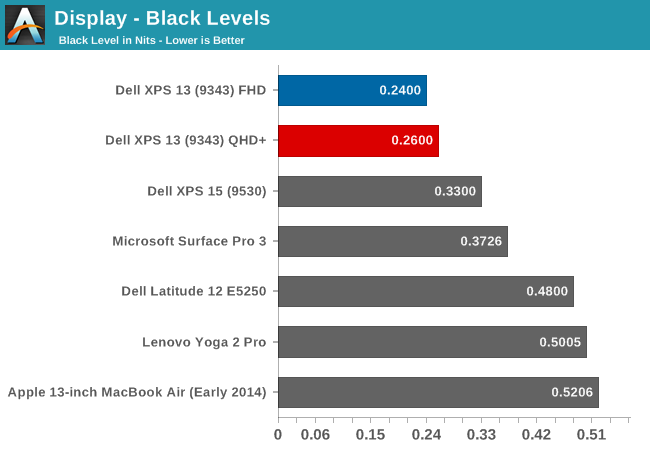
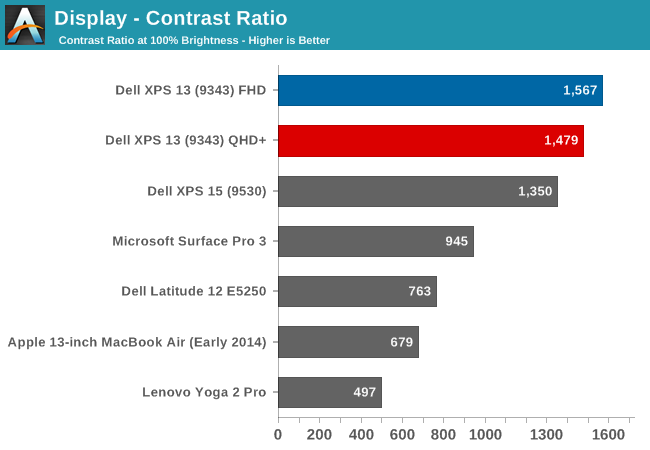
Both displays get very bright. Dell claims 400 nits brightness on the XPS 13 and we measured almost that much. Also, the black levels were very good on both displays, giving a contrast ratio close to 1500:1 on both units. Minimum brightness is around 16-17 nits on both models as well, so there is quite a bit of range on the displays to let them work on almost any situation.


On the QHD+ version, grayscale is a decent result, coming in around delta E of 3. The gamma unfortunately really drops off at the upper end of the range. The color temperature is a bit warm, and as the chart shows, the greens are a bit high. The FHD model does not fare so well, with the gamma going quite high, and the grayscale DE being almost 6.
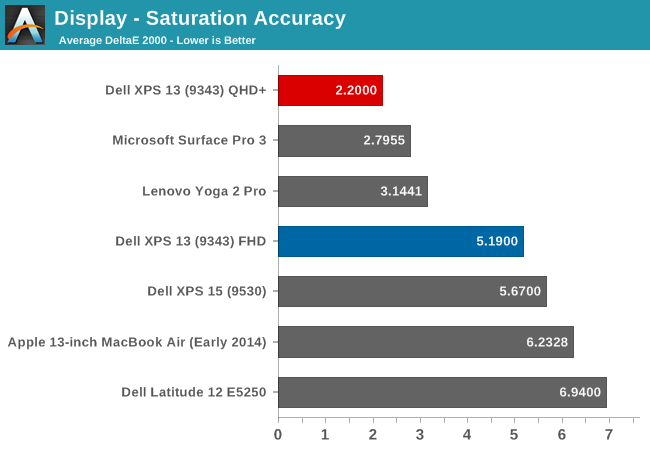
Dell does well on the saturations, with both displays being able to do the entire sRGB color space. Once again, the QHD+ model scores a lot better, with the saturation a very nice 2.2 dE, while the FHD version is closer to 5 - not an awful result, but much worse than the upgraded model.
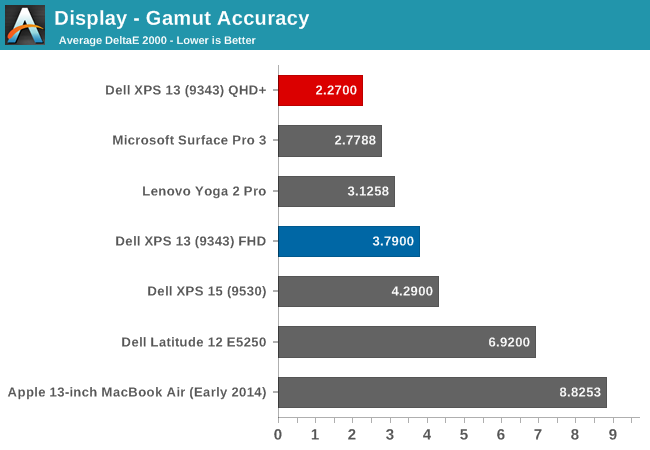
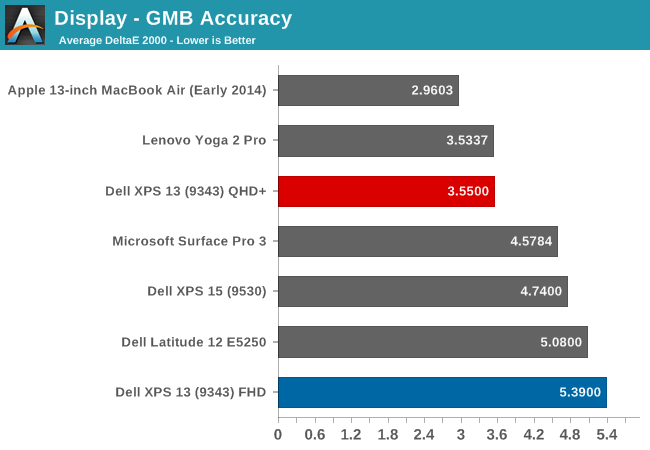
Wrapping up with the Gretag Macbeth results, again the QHD+ model does very well, with the FHD model just average. I have to note though, that even though the GMB score was very good on the QHD+ model, all of the colors that were off, with some of them around DE of 6, were the skin tones. Without calibration, anyone wanting to use this for photo editing may not much enjoy it, and with the auto-brightness issue, the calibration will not work so there is no way to see if the scores improve after calibration.
The Infinity Display is certainly one of the defining characteristics of the XPS 13, and especially with the QHD+ version the color accuracy and other characteristics are quite good. The Auto-Brightness is certainly an issue, and hopefully Dell will offer up a way to disable this either in software or the BIOS soon.


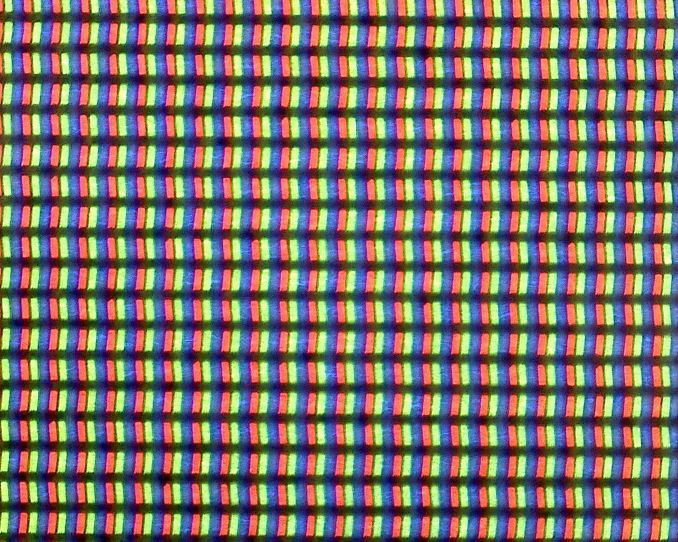
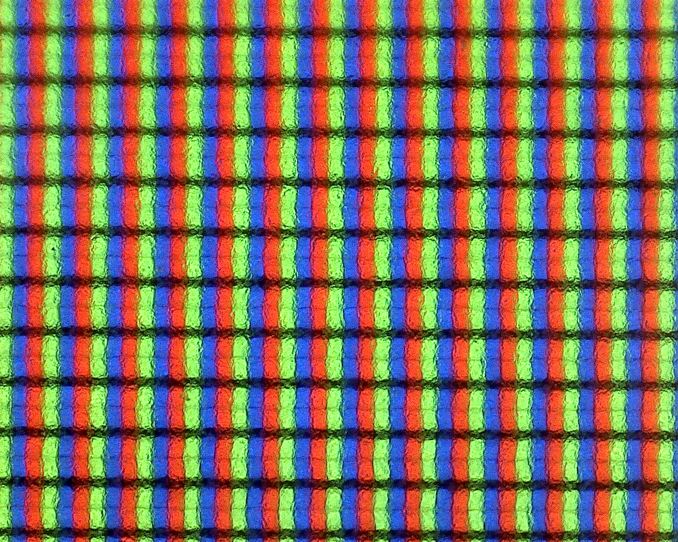
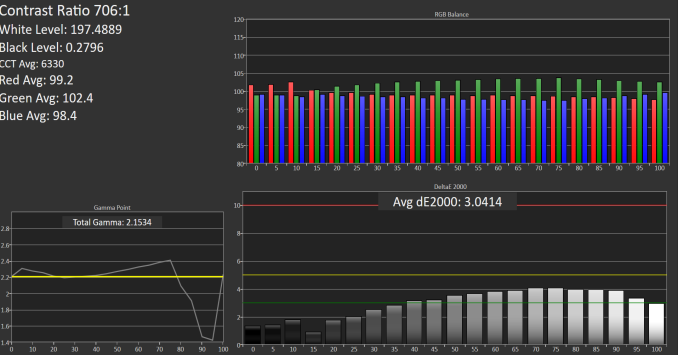
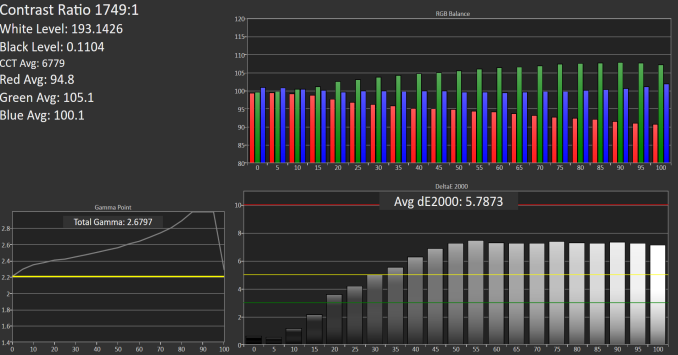
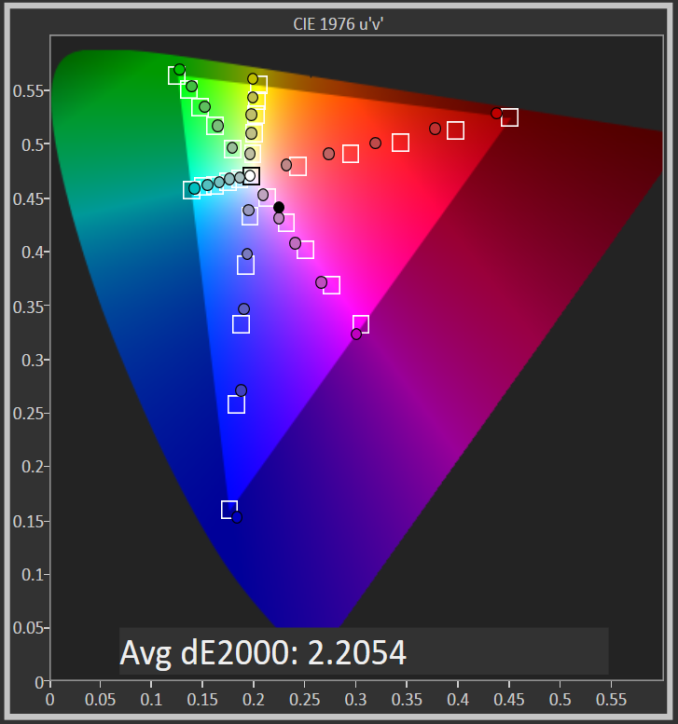

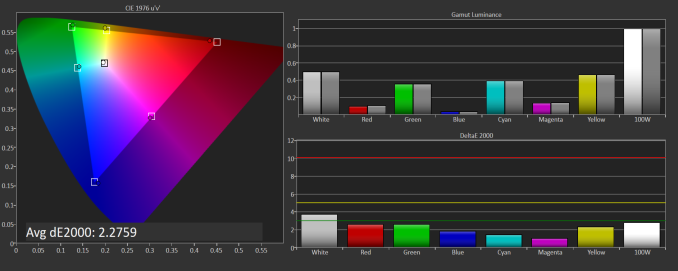
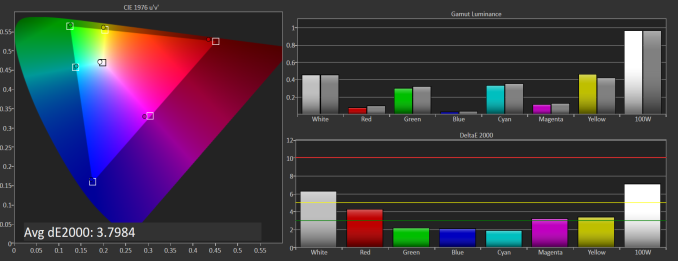

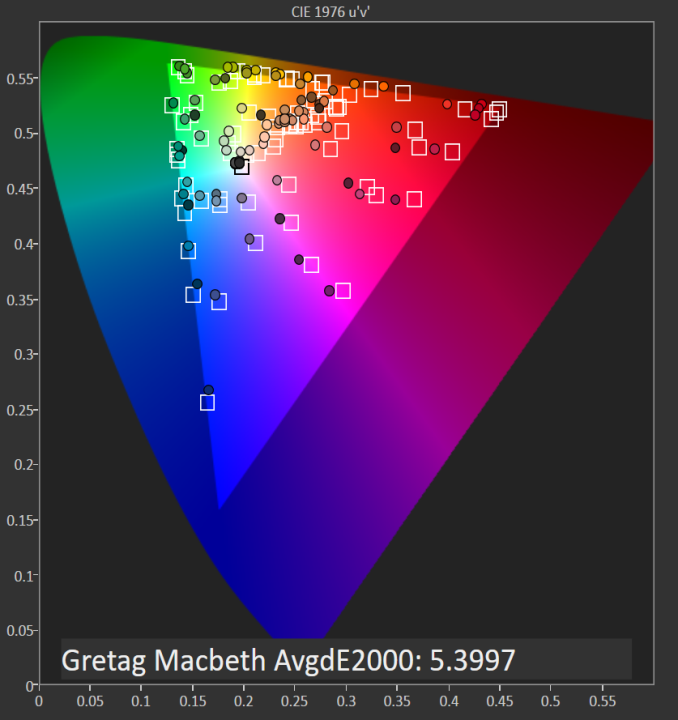








201 Comments
View All Comments
GTRagnarok - Thursday, February 19, 2015 - link
You can only upgrade the SSD. It's an M.2 form factor.Aristotle16 - Thursday, February 19, 2015 - link
I bought the Core i3 version and had serious performance issues, to the point of trying to return the device. What I found was, even after doing a clean install of Windows 8.1, that the Intel Dynamic Platform and Thermal Framework Settings (located in the advanced settings of the battery profiles) were set to 0.6GHz@15W for the Balanced and Power Saver profiles, even for plugged in mode. And for the High Performance profile, the battery setting was also set to 0.6GHz. I had not thought to look at that specific setting, but I couldn't accept that this brand new device was slower than my Venue 8 Pro tablet. It's weird that they choose to have this performance setting - even for the plugged in mode mind you - on the standard battery profile that ships with the device and/or OS. So after changing that setting, the device performance is night and day. So just a heads up if you get this and it feels slow, have a look at those settings.mayankleoboy1 - Thursday, February 19, 2015 - link
Which ssd is being used in them? A m. 2 ssd works definitely give a boost to battery and performanceBrett Howse - Thursday, February 19, 2015 - link
It is listed in the specifications - Samsung PM851.Chrispy_ - Thursday, February 19, 2015 - link
Wow, that's a HUGE battery life penalty for the QHD+ screen that delivers very slightly sharper text.It's not like 1080p @ 13.3" isn't already pin-sharp, and the IGP is useless in most games at even super low resolutions, so I'm genuinely thinking the FHD screen is a better choice here....
tipoo - Thursday, February 19, 2015 - link
I must say, I've been liking Dells output ever since they went private.01nb - Thursday, February 19, 2015 - link
Posted this yesterday at Engadget:"I have an XPS13 on my desk at the moment. It's definitely the best I've seen from Dell to date, but it's got some issues that would drive me absolutely bonkers.
The touchpad, for starters, is just not there. That is to say it cannot hold a candle to anything the fruit has put out for the past I dunno, 8 years. The webcam placement? I mean, I know you have a lot to do to make that bezel so small, but this is just stupid. Who wants to look at my nosehairs and boogs during a chat? And another pretty annoying bit - Dell, dude.... put a friggin right angle on the damn power plug already! Or please come up with some non-patent-infringing magsafe like tech dammit. This plug is unsightly, ungainly, and flat out terrible for this class of ultrabook.
Otherwise, there is a lot to like - the unreal screen, the size, plenty of speed, etc.
It's just a few minor issues from being able to truly unseat the MBA which i'm sure were made to cut cost. The problem is, with the new (r?)MBA due out any moment, it may not even get the chance."
Dell is on the right track. Hopefully they address the issues in the next version (and release it post-haste).
sporkloudly - Friday, April 10, 2015 - link
Did you have any issues with the buzzing noise everybody seems to be talking about?Laxaa - Thursday, February 19, 2015 - link
Alongside the new ThinPad, this looks like a very nice machine indeed(and great to see that PC laptops are catching up with MacBooks in terms of performance and design!) My only gripe is that I wish there was a 16GB option.Hrel - Thursday, February 19, 2015 - link
Touch is stupid, any resolution beyond 1080p is stupid. (it negatively affects EVERYTHING, as evidenced in this review.) I don't want actual glass on my laptop.If it weren't for these specific issues, mostly the glass, this would be my next executive laptop. I'm gonna need one next year. So hopefully they can fix these things before then, either that or I switch the company to Lenovo. Doesn't really matter to me, but I do really like what they did with the power adapter/battery.